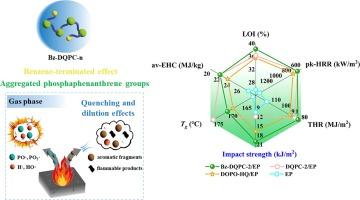The intramolecular aggregation of phosphaphenanthrene groups and benzene-terminated effect within linear phosphonate oligomers effectively enhanced the flame retardancy and toughness of epoxy resin
IF 5.8
2区 化学
Q1 POLYMER SCIENCE
引用次数: 0
Abstract
To explore the potential of a flame retardant molecular structure that simultaneously enhances the flame retardancy and physical properties of epoxy resin (EP), benzene-terminated linear phosphonate oligomers Bz-DQPC-n were synthesized. Compared with the previously prepared linear bisphenol phosphonate oligomers DQPC-n, the benzene-terminated effect of Bz-DQPC-n molecules endows EP composites with better flame retardancy and toughness. In the vertical combustion (UL 94) test, Bz-DQPC-n/EP reached a V-0 rating. For the Bz-DQPC-2 molecule, the results revealed that under the same phosphorus contents, the limiting oxygen index (LOI) value of the Bz-DQPC-2/EP reached 38.2 %, which was higher than that of DQPC-2/EP. Furthermore, the peak heat release rate (pk-HRR) and total heat release rate (THR) of Bz-DQPC-2/EP were 677 kW/m2 and 83 MJ/m2. These values decreased by 54.7 % and 27.2 % in comparison to pure EP, respectively. In addition, the incorporation of Bz-DQPC-n can enhance the glass transition temperature (Tg) of EP composites. The flame retardant mechanism research demonstrated that Bz-DQPC-n molecules produced phosphorus-containing free radicals and aromatic compound fragments during gas-phase pyrolysis. These phosphorus-containing free radicals can interrupt or inhibit the combustion chain reaction process. A proportion of the aggregated phosphaphenanthrene groups decomposed to produce aromatic compounds that remained in the condensed phase, thereby enhancing the quality of the char layer. The investigation of the impact of the end-capping effect within Bz-DQPC-n molecules on the flame retardant behavior of EP composites offers a valuable reference for designing phosphaphenanthrene compounds with high flame retardant efficiency.

线性膦酸盐低聚物中的磷菲基团和苯端效应的分子内聚集可有效提高环氧树脂的阻燃性和韧性
为了探索同时提高环氧树脂(EP)阻燃性和物理性能的阻燃分子结构的潜力,合成了苯封端的线性膦酸盐低聚物 Bz-DQPC-n。与之前制备的线性双酚膦酸酯低聚物 DQPC-n 相比,Bz-DQPC-n 分子的苯端效应赋予 EP 复合材料更好的阻燃性和韧性。在垂直燃烧(UL 94)测试中,Bz-DQPC-n/EP 达到了 V-0 级。对于 Bz-DQPC-2 分子,研究结果表明,在磷含量相同的情况下,Bz-DQPC-2/EP 的极限氧指数(LOI)值达到 38.2%,高于 DQPC-2/EP。此外,Bz-DQPC-2/EP 的峰值放热率(pk-HRR)和总放热率(THR)分别为 677 kW/m2 和 83 MJ/m2。与纯 EP 相比,这些数值分别降低了 54.7% 和 27.2%。此外,Bz-DQPC-n 的加入还能提高 EP 复合材料的玻璃化转变温度(Tg)。阻燃机理研究表明,Bz-DQPC-n 分子在气相热解过程中会产生含磷自由基和芳香族化合物碎片。这些含磷自由基可打断或抑制燃烧链反应过程。一部分聚集的磷菲基团分解后产生的芳香族化合物留在凝结相中,从而提高了炭层的质量。研究 Bz-DQPC-n 分子内的端封效应对 EP 复合材料阻燃性能的影响,为设计具有高阻燃效率的磷菲化合物提供了宝贵的参考。
本文章由计算机程序翻译,如有差异,请以英文原文为准。
求助全文
约1分钟内获得全文
求助全文
来源期刊

European Polymer Journal
化学-高分子科学
CiteScore
9.90
自引率
10.00%
发文量
691
审稿时长
23 days
期刊介绍:
European Polymer Journal is dedicated to publishing work on fundamental and applied polymer chemistry and macromolecular materials. The journal covers all aspects of polymer synthesis, including polymerization mechanisms and chemical functional transformations, with a focus on novel polymers and the relationships between molecular structure and polymer properties. In addition, we welcome submissions on bio-based or renewable polymers, stimuli-responsive systems and polymer bio-hybrids. European Polymer Journal also publishes research on the biomedical application of polymers, including drug delivery and regenerative medicine. The main scope is covered but not limited to the following core research areas:
Polymer synthesis and functionalization
• Novel synthetic routes for polymerization, functional modification, controlled/living polymerization and precision polymers.
Stimuli-responsive polymers
• Including shape memory and self-healing polymers.
Supramolecular polymers and self-assembly
• Molecular recognition and higher order polymer structures.
Renewable and sustainable polymers
• Bio-based, biodegradable and anti-microbial polymers and polymeric bio-nanocomposites.
Polymers at interfaces and surfaces
• Chemistry and engineering of surfaces with biological relevance, including patterning, antifouling polymers and polymers for membrane applications.
Biomedical applications and nanomedicine
• Polymers for regenerative medicine, drug delivery molecular release and gene therapy
The scope of European Polymer Journal no longer includes Polymer Physics.
 求助内容:
求助内容: 应助结果提醒方式:
应助结果提醒方式:


